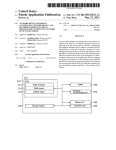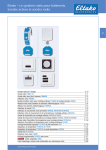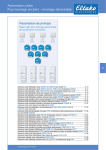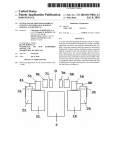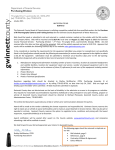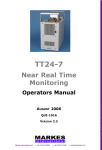Download ZGOV-G SW1~M®
Transcript
US 20130034046A1
(19) United States
(12) Patent Application Publication (10) Pub. N0.: US 2013/0034046 A1
ISHII et al.
(54)
(43) Pub. Date:
ACCESS POINT DEVICE AND
(52)
Feb. 7, 2013
US. Cl. ..................................................... .. 370/315
COMMUNICATION CONFIGURATION
PROVIDING METHOD
(57)
(75) Inventors' Hideki
ISHH ’ Nagoya_shi
(JP)’ Goki
.
.
.
.
IchIkaWa, Nagoya-sh1
(JP); Yoshlfuml
.
Haba’ Nagoya-S111 (JP)
ABSTRACT
An
accgss pointh enables Wireless bcommulnicatioin i111 a
restricte state W ere a connection 0 ject is imite to ess
than full functionali
. The access
oint chan e, in res onse
to the speci?c insttyruction being}3 receivedfg change}; the
(73)
Assigneez Buffalo Inc Nag 0ya_ Shi (JP)
’
restricted state to a non-restricted state Where the connection
object is not limited, When receiving a speci?c instruction
(21)
APPI' NO; 13/565,850
(22)
Filed:
from a user. The access point sends con?guration information
for speci?ed security communication between a Wireless ter
minal and the access point or a setup program executed to
cause the Wireless terminal to obtain the con?guration infor
(30)
Aug 3, 2012
Foreign Application Priority Data
Aug. 4, 2011
(JP) ............................... .. 2011-170975
Publication Classi?cation
(51)
Int. Cl.
H04 W 88/00
(2009.01)
mation, to the Wireless terminal, When receiving an access
from the Wireless terminal establishing connection With the
access point, in the non-restricted state- The access point
returns from the non-restricted state to the restricted state on
the occurrence of a speci?ed event. This communication con
?guration technique is highly versatile and enables the con
?guration information to be readily set in the Wireless termi
nal.
INT
ZGOV-G
SW1~M®
Patent Application Publication
Feb. 7, 2013 Sheet 1 0f 12
US 2013/0034046 A1
Fig.1
INT
[.20
r___*________________~__________ I___~_____________________l________ _1
i
I
I6O~4|A®
I
I
l
\JAP
I
I
l
I
I
I
|
I
I
I
I
I
l
l
l
I
I
I
I
I
I
I
l
l
l
I
I
I
260--®
SWI-'®
I
I
l
I
I
TEZ
I
I
l
l
I
I
I
l
l
l
.1
Patent Application Publication
Feb. 7, 2013 Sheet 2 0f 12
US 2013/0034046 A1
Fig.2
/AP
I’
_—_—_‘__‘__—__—____.______;E
_H—“
i
M
‘I
{130
IIOV/I
CPU
:>
RAM
1
ml»
| WIRELESS COMMUNICATOR
112W”
I
i
140
RECEPTOR
I
:9j
WAN I/F
113T» RESTRICTION CANCELLER
I50
I W CONFIGURATION INFORMATION
114T
I
TRANSMITTER
<: :>
I
I‘
WIRELESS
I
COMMUNICATION I/F
I
115%’ RESTRICTION RESTORER }
I
'
I60
1T6)”
REJECTER
I
’
#F
SETUP-M
F
120\/!~
m ‘1t” CONNECTION
FLASH
SOFTWARE
ROM
SETUP
:>
BUTTON
<1:
‘
L___L_ ____ ___*___ EEEEEE LiL_L_L___}
Fig.3
VIRTUAL
PORT
ORDINARY OPERATION
VAPO
MiXmOde/WPA—PSK—AES
No Change
WPA2-PSK-AES
(WPS Accepted)
VAP1:
WDS
No Change
VAPZ
'
GuestPort
(Security is Manuaily Set)
Change ESSID to "!ABC"
(Open State for New Setup Process)
Mp3,
WEP128/64
Change ESSID to "ESSIO—AOSS"
'
'
OPERATION ON PRESS OF
EASY SETUP BUTTON
(AOSS Accepted)
Patent Application Publication
Feb. 7, 2013 Sheet 3 0f 12
US 2013/0034046 A1
Fig.4
/TE2
T _____________ _—'i_m__h_—__“_1
f230
’
:>
'
RAM
'
'
|
.
CPU
<:‘
:>
I240
WIRED LAN UP
I
{250
,
WIRELESS
i220
'
FLASH ROM
I
I
,
I’; COMMUNICATION l/F
<:
'
{260
:{> EASY SETUP BUTTON
l_ _________________________ “J
Patent Application Publication
Feb. 7, 2013 Sheet 4 0f 12
US 2013/0034046 A1
Fig.5
CONNECTION SETUP
PROCESS
SHIFT TO CONNECTION
STANDBY STATE TO STAND
BY FOR CONNECTION FROM
WIRELESS TERMINAL
(VAPZ CHANGES ESSID TO
FALL IN OPEN STATE)
YES
WIRELESS TERMINAL
S340
OTHERS
NO
IDENTIFY
TYPE OF ACCESS
RESTRICTION
TIME HAS'7 ELAPSED
FIRST
SECOND
'
PROCESS
PROCESS
YES
RESTORE ESSID
END
{3350
{S360
FIRST
NEW SETUID
SECOND
NEW SETUP
PROCESS
PROCESS
\lssgo
AOSS
WES
{S370
(S380
AOSS
Wps
PROCESS PROCESS
1
Patent Application Publication
Feb. 7, 2013 Sheet 5 0f 12
US 2013/0034046 A1
Fig.6
FIRST NEW
SETUP PROCESS
NO
S410
ONLY
ONE WIRELESS
TERMINAL ESTABLISHING
CONNECTION
EQUAL TO OR
GREATER THAN SPECIFIED
VALUE
7
YES
SEND WEB PAGE (DOWNLOAD
OONFIRMATION SOREEN)
CORRESPONDING TO OS IN
\JS43O
WIRELESS TERMINAL BY
TRANSPARENT PROXY RESPONSE
DOWNLOAD
REQUEST FROM WIRELESS
TERMINAL
NO
S450
'2
RESTRICTION
TIME HAS ELAPSED
CONFIGURATION INFORMATION
TRANSMISSION PROCESS
(DEPENDINO ON OS IN
WIRELESS TERMINAL)
I
RETURN
I
'?
x3460
Patent Application Publication
Feb. 7, 2013 Sheet 6 0f 12
US 2013/0034046 A1
Fig.7
FIRST CONFIGURATION
INFORMATION
TRANSMISSION PROCESS
GENERATE CCNNECTICN
SETTINGS FILE BASED CN
x5510
CURRENT SECURITY SETTINGS
START SENDING CCNNECTICN
SETTINGS FILE To
WIRELESS TERMINAL
CHANGE OPERATING STATUS
TC CCNNECTICN REFUSAL
STATE TC PROHIBIT
x5520
\Sm
CONNECTION WITH ANOTHER
WIRELESS TERMINAL
S540
WIRELESS
TERMINAL HAS COMPLETED
DOWNLOADING
1)
S550
RESTRICTION
TIME HAS ELAPSED
?
YES
(
RETURN
I
YES
Patent Application Publication
Feb. 7, 2013 Sheet 7 0f 12
US 2013/0034046 A1
Fig.8
SECOND CONFIGURATION
INFORMATION
TRANSMISSION PROCESS
RETRIEVE OONNEOTION SETUR
SOFTWARE OORRESRONOINO TO OS “#3610
GENERATE CONNECTION
SETTINGS FILE BASED ON
CURRENT SECURITY SETTINGS
\,S62O
START SENDING CONNECTION
SETUP SOFTWARE AND
OONNEOTION SETTINGS FILE TO
,_
\TS63O
WIRELESS TERMINAL
CHANGE OPERATING STATUS TO
OONNEOTION REFUSAL STATE TO
PROHIBIT CONNECTION WITH
ANOTHER WIRELESS TERNIINAL
X5640
S650
WIRELESS
TERMINAL HAS COMPLETED
DOWNLOADING
(8660
RESTRICTION
TIME HAS ELAPSED
'7
YES
(
RETURN
I
YES
Patent Application Publication
Feb. 7, 2013 Sheet 8 0f 12
US 2013/0034046 A1
Fig.9
I/APZ
_
m
_
_
_
_
_
w
_
M
_
_
_
_
_
_
_
____L_______._—_
T
T
Hog/I“
CPU
:{> RAM
I
URI/F
| WIRELESS COMMUNICATOR"T
112WA
{140
RECEPTOR
\
:§>
WAN I/F
113w» RESTRICTION OANGELLER
I ‘I 4 I /_ CONFIGURATION INFORMATION
TRANSMITTER
\T
115»I/’* RESTRICTION RESTORER
116A”
]
I 17¢»
{150
<:
:1;
COMMUNICATION I/F
(160
REJECTER
AUTHENTICATOR
:>
!
EASY SETUP
BUTTON
I
‘KL/I
ml” CONNECTION
FLASH ROM
SETUP
I
WIRELESS
I
SOFTWARE
<\:_
l
i
Patent Application Publication
Feb. 7, 2013 Sheet 9 0f 12
US 2013/0034046 A1
Fig/IO
FIRST NEW
SETUP PROCESS
NO
S410
ONLY
ONE WIRELESS
TERMINAL ESTABLISHING
CONNECTION
'7
YES
SEND WEB PAGE (BUTTON
RE~PRESS GUIDE SCREEN)
OORRESPONDING TO OS IN
x3720
WIRELESS TERMINAL BY
TRANSPARENT PROXY RESPONSE
BUTTON
RE-PRESS IS REOEIvED
NO
I?
S740
RESTRICTION
TIME HAS ELAPSED
CONFIGURATION INFORMATION
TRANSMISSION PROOESS
(DEPENDING ON OS IN
WIRELESS TERMINAL)
I
@
“3460
Patent Application Publication
Feb. 7, 2013 Sheet 10 0f 12
US 2013/0034046 A1
Fig.11
FIRST NEW
SETUP PROCESS
NO
S410
ONLY
ONE WIRELESS
TERMINAL ESTABLISHING
CONNECTION
I)
YES
SENO WEB PAGE (PIN CODE
ENTRY SCREEN) CORRESPONDING
,
TO OS IN WIRELESS TERMINAL BY x5820
TRANSPARENT PROXY RESPONSE
S830
PIN
INPUT IS RECEIVED
NO
o
S840
RESTRICTION
TIME HAS ELAPSED
SUCCESSFUL
AUTHENTICATION
'7
YES
CONFIGURATION INFORMATION
TRANSMISSION PROCESS
(OEPENOING ON OS IN
WIRELESS TERMINAL)
(
RETURN
)
P
“3460
Patent Application Publication
Feb. 7, 2013 Sheet 11 0f 12
US 2013/0034046 A1
Fig.12
/AP3
_
_
_
WW
A
W
CUT.MEO
M
DHCGIT
W
R
LMR
E
m
_
_
A“N
m
CACJIC
ilw!
_l
f
f
p
f
F
A
L
L
w
m
n
2L6
8_HTECA
LSTECET
m
g
W
Em TL04
GR _Am??
RT.FNM
0S.RR SOTU08E0N
E
NU
REUvl.
W
_
H
WM
E
O
_“U0WW
NNTRMR
H_Rm0
N_NMO0..M
i
j
QL
_3EANST5
SBRNWM_
6ST_O0EOV“Cm1/5FN
APWAL_
OERNEDR_M
SN
RRTF0T.1
RTW.
AL
v
W,
MV
L
FJ
RN H_ w
a
c
T1/)L14|
Patent Application Publication
Feb. 7, 2013 Sheet 12 0f 12
US 2013/0034046 A1
Fig.13
SECOND CONFIGURATION
INFORMATION
TRANSMISSION PROCESS
[S910
RETRIEVE CONNECTION SETUP
COMMUNICATION SOFTWARE
CORRESPONDING TO OS
START SENDING CONNECTION
SETUP COMMUNICATION SOFTWARE
TO WIRELESS TERMINAL
CHANGE OPERATING STATUS TO
CONNECTION REFUSAL STATE TO
PROHIBIT CONNECTION WITH
ANOTHER WIRELESS TERMINAL
S940
WIRELESS
NO
TERMINAL HAS COMPLETED
DOWNLOADING
YES
RESTRICTION
TIME HAS ELAPSED
'2
fseso
SECOND NEW SETUP PROCESS
(MAKE COMMUNICATION WITH
WIRELESS TERMINAL PROVIDE
WIRELESS TERMINAL WITH
CONFIGURATION INFORMATION
AFTER MUTUAL CONFIRMATION)
I
RETURN
)
Feb. 7, 2013
US 2013/0034046 A1
ACCESS POINT DEVICE AND
COMMUNICATION CONFIGURATION
PROVIDING METHOD
CROSS-REFERENCE TO RELATED
APPLICATIONS
wireless terminal. This enables the user to readily perform
security communication between the wireless terminal and
the access point device.
[0009] Another aspect of the disclosure provides the con
?guration of a communication con?guration providing
method. According to a second aspect, there is provided a
communication con?guration providing method that pro
[0001] This application claims the bene?t of priority under
35 U.S.C. §ll9 to Japanese Patent Application No. 2011
170975 ?led on Aug. 4, 2011, which is hereby incorporated
by reference in its entirety and for all purposes.
vides a wireless terminal with con?guration information,
which is used to enable speci?ed security communication
BACKGROUND OF THE INVENTION
restricted state where a connection object connectable with
the access point device is limited to a non-restricted state
[0002] 1. Field of the Invention
[0003] The disclosure relates to communication con?gura
tion technique for wireless communication.
[0004] 2. Description of the Related Art
[0005] In order to perform security communication ensur
ing security in a wireless LAN, it is required to set con?gu
where the connection object is not limited, when receiving a
between an access point device and the wireless terminal. The
communication con?guration providing method changes a
speci?c instruction given by a user; sends digital data, which
is used to cause a connected wireless terminal that has estab
lished connection with the access point device, to obtain the
con?guration information, to the connected wireless termi
ration information including encryption settings and authen
nal, when receiving an access from the connected wireless
terminal, in the non-restricted state; and returns from the
tication information in both an access point and a wireless
non-restricted state to the restricted state on occurrence of a
terminal (station). The user’s manual setup of such con?gu
ration information is rather troublesome, and the manual
speci?ed event after a restriction cancellation time when the
restricted state is changed to the non-restricted state.
setup may be di?icult for the user unfamiliar with the wireless
[0010]
LAN. The following technique (hereinafter referred to as
to be readily set in the access point device.
[0011] The invention is not limited to the access point
device or the communication con?guration providing method
“auto-con?guration technique”) has accordingly been devel
oped. This technique establishes mutual communication
between the access point and the wireless terminal according
to an asymmetric protocol and enables the access point to
provide the wireless terminal with con?guration information
and automatically set the con?guration information in the
wireless terminal. Known examples of such auto-con?gura
tion technique include AOSS (AirStation One-Touch Secure
System: registered trademark by BUFFALO INC.) and WPS
(Wi-Fi Protected Setup).
[0006] In the auto-con?guration technique, for example,
This method enables the con?guration information
described above but may also be implemented by various
other applications, for example, a program for the access
point device, a storage medium in which such a program is
recorded and a communication con?guration method.
BRIEF DESCRIPTION OF THE DRAWINGS
[0012] FIG. 1 illustrates the general con?guration of a net
work system 20 established by using an access point AP
the user presses a button provided on the access point and a
according to a ?rst embodiment of the access point device of
button provided on the wireless terminal within a speci?ed
time to start speci?c communicationbetween the access point
and the wireless terminal and set the con?guration informa
tion in the wireless terminal. This auto-con?guration tech
nique is enabled on the premise that a special program is
installed in advance in the wireless terminal as well as in the
the disclosure;
[0013] FIG. 2 schematically illustrates the con?guration of
access point. The auto-con?guration technique is thus not
a wireless terminal TE2;
[0016] FIG. 5 is a ?owchart showing a procedure of con
able to set the con?guration information in the wireless ter
minal without installation of the special program.
[0007]
Consequently, by taking into account at least part of
the above problem, there is a need to provide communication
con?guration technique that is highly versatile and enables
con?guration information to be readily set in a wireless ter
minal.
SUMMARY
[0008]
One aspect of the disclosure provides the con?gu
ration of an access point device. According to a ?rst aspect,
there is provided an access point device that relays wireless
communication of a wireless terminal. In a non-restricted
state where limitation of a connection object connectable
with the access point device is cancelled, when receiving an
access from a connected wireless terminal that is the wireless
the access point AP;
[0014] FIG. 3 illustrates a speci?c example of virtual ports
VAPO to VAP3 implemented by the access point AP;
[0015]
FIG. 4 schematically illustrates the con?guration of
nection setup process performed by the access point AP;
[0017]
FIG. 6 is a ?owchart showing a ?ow of ?rst new
setup process in the connection setup process;
[0018] FIG. 7 is a ?owchart showing a ?ow of ?rst con?gu
ration information transmission process in the ?rst new setup
process;
[0019] FIG. 8 is a ?owchart showing a ?ow of second
con?guration information transmission process in the ?rst
new setup process;
[0020]
FIG. 9 schematically illustrates the con?guration of
an access point AP2 according to a second embodiment;
[0021] FIG. 10 is a ?owchart showing a ?ow of ?rst new
setup process performed by the access point AP2;
[0022] FIG. 11 is a ?owchart showing a ?ow of ?rst new
setup process according to one modi?cation of the second
terminal establishing connection with the access point device,
this access point device sends digital data, which is used to
enable speci?ed security communication between the con
embodiment;
nected wireless terminal and the access point device, to the
of an access point AP3 according to a third embodiment; and
[0023]
FIG. 12 schematically illustrates the con?guration
Feb. 7, 2013
US 2013/0034046 A1
[0024]
FIG. 13 is a ?owchart showing a ?ow of second
command for the second new setup process. The wireless
con?guration information transmission process performed
terminal TE2, however, does not support the auto-con?gura
by the access point AP3.
tion, such as AOSS or WPS. The wireless terminal TE3, on the
DESCRIPTION OF THE PREFERRED
EMBODIMENTS
A. First Embodiment
[0025] The following describes embodiments of the disclo
sure with reference to the accompanying drawings.
A-l. General Con?guration of Network System 20
[0026] FIG. 1 illustrates the general con?guration of a net
work system 20 established by using an access point AP as
one embodiment of the access point device of the disclosure.
According to this embodiment, the network system 20 is
implemented as a wireless LAN in conformity with IEEE
802.11 standard. The network system 20 includes the access
point AP and wireless terminals TE1 to TE3 as illustrated in
FIG. 1.
[0027] The access point AP serves to relay wireless com
munication of the wireless terminals TE1 to TE3. This access
point AP has the router function and is connected to the
Internet INT by a network cable. According to this embodi
ment, the access point AP supports conventionally known
AOSS and WPS processes as the auto-con?guration to auto
matically provide the wireless terminal with con?guration
information for speci?ed security communication, such as
encryption settings and authentication information. The
access point AP also supports a process of readily providing
the wireless terminal with con?guration information (herein
after referred to as “new setup process”). The new setup
process is the novel technique implemented according to this
embodiment. The new setup process includes “?rst new setup
process” to provide the wireless terminal with con?guration
information in the form of digital data in response to the
simple user operation and “second new setup process” to
automatically provide the wireless terminal with con?gura
tion information in the form of digital data. In the description
below, the term “new setup process” is used as collective term
including both the ?rst new setup process and the second new
setup process.
[0028]
The access point AP has an easy setup button 160
operated by the user to give a speci?c instruction directly to
the access point AP. The easy setup button 160 is operated to
give an instruction to start AOSS process, WPS process or
new setup process to the access point AP. According to this
embodiment, the easy setup button 160 is used for all the
AOSS process, the WPS process and the new setup process.
According to another embodiment, separate buttons may be
provided for the respective processes.
[0029] According to this embodiment, the wireless termi
nal TE1 is a general-purpose cell phone having a display and
a wireless communication interface. This wireless terminal
TE1 is a model that supports neither the auto-con?guration,
such as AOSS or WPS nor the second new setup process.
[0030]
The wireless terminals TE2 and TE3 are Ethernet
(registered trademark) converters. The Ethernet converter has
a wireless communication interface and a wired LAN inter
face and performs format conversion based on these commu
other hand, supports the auto-con?guration, such as AOSS or
WPS and is provided with an easy setup button SW1 to give
a start command for the AOSS process or the WPS process.
The device type of the wireless terminal is not limited to those
described in this embodiment. The wireless terminal TE1 is
any device having equipment serving as a user interface, for
example, a display, and an interface for wireless communi
cation and may be, for example, a personal computer, a PDA
(personal digital assistant), a portable game machine or a
home appliance. The wireless terminal TE2 may be, for
example, a personal computer, a RDA, a printer, a stationary
game machine or another electric appliance. The wireless
terminal TE2 may not be provided with a display. The wire
less terminal TE2 provided with a display may receive a start
command for the second new setup process via GUI (Graphi
cal User Interface) displayed by a program installed in the
wireless terminal TE2.
[0031] The access point AP provides any of the wireless
terminals TE1 to TE3 with con?guration information, in
response to the simple user operation. The following
describes the con?guration of the access point AP to provide
the wireless terminals TE1 to TE3 with con?guration infor
mation.
A-2. General Con?guration of Access Point AP
[0032] FIG. 2 schematically illustrates the con?guration of
the access point
[0033] AP. As illustrated, the access point AP has a CPU
110, a ?ash ROM 120, a RAM 130, a WAN interface (I/F)
140, a wireless communication interface 150 and the easy
setup button 160. The CPU 110, the ?ash ROM 120, the RAM
130, the WAN interface WO 140, the wireless communication
interface 150 and the easy setup button 160 are intercon
nected by a bus.
[0034]
The CPU 110 loads and executes a program, such as
?rmware, stored in the ?ash ROM 120, on the RAM 130 to
control the overall operations of the access point AP. The CPU
110 executes this program to serve as a wireless communica
tor 111, a receptor 112, a restriction canceller 113, a con?gu
ration information transmitter 114, a restriction restorer 115
and a rej ecter 116. The details of these functional blocks will
be described later.
[0035] Connection setup software 121 is recorded in the
form of digital data in the ?ash ROM 120. The connection
setup software 121 is a program executed to set the con?gu
ration information generated by the access point AP into the
wireless terminal. This connection setup software 121 is sent
in the form of digital data to the wireless terminal and is
loaded and executed on a memory in the wireless terminal.
Multiple pieces of the connection setup software 121 are
provided corresponding to a plurality of different operating
systems (OS) that may be installed in the wireless terminal.
Examples of such OS include iOS, Android (registered trade
mark by Google Inc.), Windows (registered trademark by
Microsoft Corporation). The “different operating systems”
may include different versions of an identical. OS.
[0036] The WAN interface 140 is an interface for connect
nication standards to relay communication packets. The wire
ing with an external network by a ?xed line. According to this
embodiment, the WAN interface 140 is connected to the
less terminal TE2 supports the second new setup process and
is provided with an easy setup button 260 to give a start
nication interface 150 is a control circuit for establishing
Internet INT as the external network. The wireless commu
Feb. 7, 2013
US 2013/0034046 A1
beacon or by requiring the Wireless terminal to provide
authentication information before alloWing connection With
Wireless communication in conformity With a Wireless LAN
standard. The Wireless communication interface 150 is pro
vided With hardware, such as a modulator, an ampli?er and an
the access point AP.
antenna. The Wireless communication interface 150 is con
trolled by the CPU 110 or more speci?cally its Wireless com
municator 111 to implement the functions as the access point.
[0040] The access point AP supports multi-SSID. More
speci?cally, the access point AP is con?gured such that one
physical access point AP is operable as a plurality of virtual
[0037] The easy setup button 160 is operated by the user to
give a speci?c instruction, i.e., a start command for the AOSS
access points that serve as logical access points. The access
point AP is able to set an SSID for each virtual access point.
process, the WPS process or the neW setup process, to the
access point AP as described above. The interface for receiv
description hereof.
ing a start command is, hoWever, not limited to the button. For
example, in the access point AP provided With a display, the
interface for receiving a start command may be GUI (Graphi
cal User Interface). In another example, the interface for
receiving a start command may be con?gured to use infrared
communication or a contact or non-contact IC card. In gen
This virtual access point is also called “virtual port” in the
[0041] FIG. 3 illustrates a speci?c example of the virtual
ports implemented by the access point AR In this illustrated
example, the access point AP has four virtual ports VAPO to
VAP3. The virtual port VAPO is used for encrypted commu
nication in WPA (Wi-Fi ProtectedAccess)iPSK (PreShared
Key)iAES (Advanced Encryption Standard) mode or in
eral, the interface may be any input in the form of direct touch,
i.e., directly operable by the user, or in the form of near ?eld
communication in the vicinity of the access point AP, to give
WPA2iPSKiAES mode. According to this embodiment,
the virtual port VAPO may be enabled by the user’s manual
a start command to the access point AP. This con?guration
tual port VAP1. is used for WDS (Wireless Distribution Sys
advantageously prevents a start command from being given
tem)-based communication.
from a location distant from the access point AP to the access
[0042] The virtual port VAP2 is used as a guest port. The
guest port is provided to alloW the user other than the user of
point AP Without the user’s acknowledgement or against the
user’ s intention. From this point of vieW, the narroWer cover
age is preferable to give an instruction to the access point AP.
For example, the coverage may be Within a range of 10 meters
from the access point AP, preferably Within a range of 5
meters, or more preferably Within a range of 1 meter. This
coverage is most preferably Within a range of 0 meter to alloW
the user to give a start command to the access point AP only
by a direct touch on the access point AP.
[0038] The access point AP is con?gured to enable Wireless
communication in the restricted state. In the “restricted state”,
the connection object connectable With the access point AP is
limited. The connection object may be limited in any of
various forms. Limiting the connection object in any form
causes the access point AP to fall in the restricted state.
According to this embodiment, the Wireless communicator
setup, as Well as the WPS-based auto-con?guration. The vir
the access point AP to make a connection to the Internet INT.
The security of the guest port is set by the user’s manual
operation. The virtual port VAP3 is used for encrypted com
munication in WEP (Wired Equivalent Privacy) 128/64
mode. According to this embodiment, the virtual port VAP3
may be enabled by the user’s manual setup, as Well as the
AOSS-based auto-con?guration.
[0043]
The virtual port VAPO is also used for the WPS
process When the CPU 110 or more speci?cally its receptor
112 detects the user’s press of the easy setup button 160. In
other Words, the virtual port VAPO is used for communication
based on the WPS registration protocol. There is no change in
operation of the virtual port VAP1 When the CPU 110 detects
a press of the easy setup button 160.
111 of the CPU 110 hasANY connection refusal function and
[0044]
SSID (Service Set Identi?er) concealing function as the func
tions to limit the connection object. The “ANY connection
refusal function” refuses a connection request With the setting
110 detects a press of the easy setup button 160, the ESSID is
of an SSID to vacancy or ANY from the Wireless terminal.
The “SSID concealing function” excludes an SSID (more
In the virtual port VAP2, hoWever, When the CPU
changed to “!ABC”. The changed
[0045] ESSID is included inbeacon sent by the access point
AP. This enables even a non-special Wireless terminal receiv
ing the beacon to make a connection With the access point AP
speci?cally ESSID (Extended Service Set Identi?er) in this
(virtual port VAP2) by sending a connection request With the
embodiment) from beacon sent by the access point AP at
setting of ESSID to “!ABC”. In other Words, in response to
detection of a press of the easy setup button 160, the state of
the virtual port VAP2 is changed to the non-restricted state
regular intervals. These functions limit the connection object
connectable With the access point AP to the user’s Wireless
terminal that is informed of the ESSID set in the access point
(open state) having no limitation of the connection object
AP, i.e., the Wireless terminal With the setting of the same
connectable With the access point AR The virtual port VAP2
ESSID as the ESSID set in the access point AP.
in the non-restricted state is used for the neW setup process as
[0039]
described later.
In WPS-based or AOSS-based auto-con?guration,
even the user’s Wireless terminal that is not informed of the
ESSID set in the access point AP is able to make a connection
With the access point AP by detecting beacon from the access
point AP and performing a connecting operation. In WPS
based or AOSS-based auto-con?guration, hoWever, the Wire
less terminal is required to support WPS or AOSS. Addition
ally, the user is required to give a start command for auto
con?guration to both the access point AP and the Wireless
terminal Within a speci?ed period. This means that the access
point AP is in the restricted state during the WPS-based or
AOSS-based auto-con?guration. The connection object may
be limited, for example, by encrypting the ESSID included in
[0046]
Changing the ESSID to “!ABC” has the folloWing
advantageous effects. When the Wireless terminal detects a
plurality of access points by passive scan or by active scan,
such setting of the changed :ESSID enables this access point
AP (virtual port VAP2) to be displayed at the top of a list of
detected access points. During the ?rst neW setup process
described later, the user operating the Wireless terminal can
thus readily ?nd the access point AP as the connection desti
nation in the list, in order to make a connection betWeen the
Wireless terminal and the access point AP. This improves the
user-friendliness. The changed ESSID is preferably a value
that is high on the list. in an application of the list displaying
Feb. 7, 2013
US 2013/0034046 Al
the detected access points in a descending order, the changed
ESSID may preferably be a value that is at the top on the list
in the descending order.
[0047] The virtual port VAP3 is used for the AOSS process
When the CPU 110 detects a press of the easy setup button
160. More speci?cally, in response to detection of a press of
the easy setup button 160, the ESSID of the virtual port VAP3
is changed to, for example, “ESSID-AOSS” or “ESSID
AOSS1”. The changed ESSID is included in the beacon sent
by the access point AP. The Wireless terminal receiving this
beacon is alloWed to make a connection With the access point
AP (virtual port VAP3) only When the Wireless terminal sup
ports AOSS and receives a start command for the AOSS
process Within a speci?ed time. The AOSS process starts on
establishment of a connection betWeen the Wireless terminal
and the virtual port VAP3.
is triggered When the CPU 110 or more speci?cally its recep
tor 112 of the access pointAP detects a press of the easy setup
button 160 to receive a start command.
[0053] As shoWn in FIG. 5, on the start of the connection
setup process, the
[0054] CPU 110 or more speci?cally its restriction cancel
ler 113 shifts the state of the access point AP to a connection
standby state to stand by for a connection from any of the
Wireless terminals TE1 to TE3 (step S310). In this connection
standby state, the virtual ports VAPO and VAP1 have no
changes but the other virtual ports VAP2 and VAP3 have
changes as shoWn in the right column of FIG. 3. The state of
each port is described more speci?cally. The virtual port
VAP2 changes the ESSID to fall in the nonrestricted state
(open state). In the connection standby state, When receiving
the Wireless terminal TE2. As illustrated, the Wireless termi
a connection request including the changed ESSID from the
Wireless terminal, the virtual port VAP2 accordingly makes a
connection With the Wireless terminal sending the connection
request. For example, the user of the Wireless terminal TE1
(FIG. 1) operates the Wireless terminal TE1 to detect the
nal TE2 includes a CPU 210, a ?ash ROM 220, a RAM 230,
a Wired LAN interface 240, a Wireless communication inter
the detected access point AP (virtual port VAP2) and the
A-3. General Con?guration of Wireless Terminal TE2
[0048]
FIG. 4 schematically illustrates the con?guration of
face 250 and the easy setup button 260. The CPU 210, the
?ash ROM 220, the RAM 230, the Wired LAN interface 240,
the Wireless communication interface 250 and the easy setup
button 260 are interconnected by a bus.
[0049] The CPU 210 loads and executes a program, such as
?rmware, stored in the ?ash ROM 220, on the RAM 230 to
control the overall operations of the Wireless terminal TE2.
The CPU 210 also has the function of performing the second
neW setup process With the access point AP. The Wired LAN
interface 240 is an interface for connecting With a Wired LAN.
According to this embodiment, the Wired LAN interface 240
has a Wired port. The Wired LAN interface 240 is connected
With an electronic device Without a Wireless communication
interface. The Wireless communication interface 250 is a
control circuit for Wireless communication in conformity
With a Wireless LAN standard. The Wireless communication
interface 250 is controlled by the CPU 210 to implement the
functions as the station.
[0050]
The easy setup button 260 is operated to give a start
command for the second neW setup process to the Wireless
terminal TE2. The interface for receiving a start command is
not limited to the button as described previously With respect
to the easy setup button 160 of the access point AP.
[0051] The Wireless terminal TE3 differs from the Wireless
terminal TE2 by: (i) replacement of the function of perform
ing the second neW setup process of the Wireless terminal TE2
With the function of performing the AOSS process or the WPS
process; and (ii) replacement of the easy setup button 260 of
the Wireless terminal TE2 With the easy setup button SW1
operated to give a start command for the AOSS process or the
WPS process. OtherWise the Wireless terminal TE3 has the
similar con?guration to that of the Wireless terminal TE2.
A-4. Connection Setup Process
[0052] The folloWing describes the connection setup pro
cess performed by the access point AP. During the “connec
tion setup process” in the netWork system 20, the access point
AP provides the Wireless terminals TE1 to TE3 With con?gu
ration information for speci?c security Wireless communica
access point AR The user then makes a connection betWeen
Wireless terminal TE1 by the user’s manual operation. In one
example of the “manual operation”, the user may select the
access point AP from the list of detected access points (i.e.,
the list of detected ESSIDs of access points) and give an
instruction to connect With the selected access point AP via
GUI on the display of the Wireless terminal TE1. In response
to such user operation, the Wireless terminal TE1 sends a
connection request including the detected ESSID of the
access point AP to the selected access point AP. In another
example, When the user of the Wireless terminal TE2 (FIG. 1)
presses the easy setup button 260 of the Wireless terminal
TE2, the Wireless terminal TE2 detects the access point AP
and automatically makes a connection With the detected
access point AP (virtual port VAP2). In the description beloW,
the time When the state of the virtual port VAP2 is changed
from the restricted state to the non-restricted state is called
“restriction cancellation time”.
[0055]
In the connection standby state, the virtual port
VAPO falls in a standby status for a WPS connection request.
The virtual port VAPO in the standby status makes a connec
tion With the Wireless terminal TE3 only When a WPS con
nection request is received from the Wireless terminal TE3
supporting WPS. The virtual port VAPO does not make a
connection With either of the Wireless terminals and TE2 that
do not support WPS. In the connection standby state, the
virtual port VAP3 falls in a standby status for an AOSS con
nection request. The virtual port VAP3 in the standby status
makes a connection With the Wireless terminal TE3 only When
an AOSS connection request is received from the Wireless
terminal TE3 supporting AOSS. The virtual port VAP3 does
not make a connection With either of the Wireless terminals
TE1 and TE2 that do not support AOSS. When the user of the
Wireless terminal. TE3 presses the easy setup button SW1 of
the Wireless terminal TE3, the Wireless terminal TE3 detects
the access point AP and automatically makes a connection
With the detected access pointAP (virtual por‘tVAPO or virtual
port VAP3).
[0056]
After shifting to the connection standby state, the
CPU 110 of the access point AP determines Whether there is
an access from the Wireless terminal making a connection
tion. FIG. 5 shoWs a ?oW of the connection setup process.
With the access point AP (step S320). For example, after
According to this embodiment, the connection setup process
establishment of a connection betWeen the Wireless terminal
Feb. 7, 2013
US 2013/0034046 A1
TE1 and the virtual port VAP2, When the user of the Wireless
terminal TE1 performs an operation to connect With an arbi
trary URL (Uniform Resource Locator) by a WEB browser
installed in the Wireless terminal. TE1, the Wireless terminal
TE1 has an access to the access point AP (virtual port VAP2).
The Wireless terminal TE1 accordingly sends an HTTP (Hy
pertext Transfer Protocol) request to the access point AP
(virtual port VAP2). This user operation enables the ?rst neW
setup process.
[0060] At step S390, the virtual ports VAPO and VAP3 are
also released from the connection standby state for WPS or
AOSS. The virtual ports VAPO to VAP3 are accordingly
restored to the state of ordinary operation shoWn in the left
column of FIG. 3. The restriction time of step S330 may be
different values for the virtual ports VAPO, VAP2 and VAP3.
For example, the user’s manual operation to select the access
point AP and give an instruction to connect With the access
is performed according to an asymmetric protocol by inter
point AP may take a longer time than the simple press of the
easy setup button SW1. The restriction time for the virtual
port. VAP2 may thus be set longer than the restriction time for
the virtual ports VAPO and VAP3. This con?guration achieves
a balance betWeen the time required for the operation of the
Wireless terminal and the security. The “restriction time” may
be a “time length” measured by, for example, a real time clock
but may be speci?ed by a period other than the time length,
communication betWeen the access point AP and the Wireless
terminal TE2. According to this embodiment, the second neW
number of NOP cycles.
[0057] When the user of the Wireless terminal TE2 presses
the easy setup button 260 of the Wireless terminal TE2 to
establish a connection betWeen the Wireless terminal TE2 and
the access point AP (virtual port VAP2), the Wireless terminal
TE2 automatically performs the second neW setup process
subsequent to establishment of the connection. This process
setup process is performed Without encrypting the WPS reg
istration protocol. More speci?cally, While the registration
protocol generally encrypts communication after message
such as a period When the CPU 110 performs a predetermined
[0061]
When there is an access from the Wireless terminal
M8 speci?ed by the WPS standard, the second neW setup
(step S320: YES), on the other hand, the CPU 110 subse
quently identi?es the type of the access (step S340). More
speci?cally, the CPU 110 identi?es Which of the ?rst neW
process does not encrypt communication after message M8.
The message M8 denotes a frame to provide the Wireless
terminal With con?guration information. The second neW
setup process, the second neW setup process, the AOSS pro
cess, the WPS process and the others, the access from the
Wireless terminal is based on. The type of the access is iden
setup process may alternatively be formed Without encrypting
ti?able based on a destination port number included in a TCP
header of a communication packet used for the access. The
the AOSS process. In general, the second neW setup process
may use the virtual port VAP2 in the non-restricted state to
make intercommunication betWeen the access point and the
station according to an asymmetric protocol and enable the
access point to provide the station With con?guration infor
mation.
[0058]
As clearly understood from the above description,
the second neW setup process is triggered by an access from
the Wireless terminal TE2 to the access point AP, i.e., trans
mission of an EAPOL (EAP-over LAN)iStart message as
the ?rst action of the registration protocol. When the user of
the Wireless terminal TE3 presses the easy setup button SW1
different speci?cations of the Wireless terminals TE1 to TE3
lead to different types of accesses enabled by the Wireless
terminals TE1 to The Wireless terminal TE1 enables an access
based on the ?rst neW setup process. The Wireless terminal
TE2 enables an access based on the second neW setup process.
The Wireless terminal TE3 enables an access based on the
AOSS process or the WPS process.
[0062]
When the access is identi?ed as based on the ?rst
neW setup process (step S340: FIRST PROCESS), the CPU
110 performs the ?rst neW setup process to provide the Wire
less terminal TE1 as the access source With con?guration
of the Wireless terminal TE3 to establish a connection With the
information (step S350). The details of the ?rst neW setup
access point AP (virtual port VAPO or virtual port VAP3), the
Wireless terminal. TE3 automatically performs theAOSS pro
process Will be described later. When the access is identi?ed
as based on the second neW setup process (step S340: SEC
OND PROCESS), the CPU 110 or more speci?cally its con
cess or the WPS process subsequent to establishment of the
connection. The AOSS process and the WPS process are
knoWn in the art and are thus not described in detail here. Like
?guration information transmitter 114 performs the second
neW setup process described above to provide the Wireless
the second neW setup process described above, the AOSS
process or the WPS process is also triggered by an access
from the Wireless terminal TE3 to the access point AP. The
terminal TE2 as the access source With con?guration infor
decision of step S320 accordingly includes determination of
TE2 and provides the Wireless terminal TE2 With con?gura
Whether there is any access from the Wireless terminal for any
of the ?rst neW setup process, the second neW setup process,
the AOSS process and the WPS process.
[0059] When there is no access from the Wireless terminal
tion information after mutual validation. When the access is
identi?ed as based on the AOSS process (step S340: AOSS),
(step S320: NO), the CPU 110 of the access point AP deter
mines Whether elapsed time since the restriction cancellation
time reaches a speci?ed restriction time (step S330). When
the elapsed time does not yet reach the restriction time (step
S330: NO), the CPU 110 returns to step S320. When the
elapsed time reaches the restriction time Without any access
from the Wireless terminal (step S330: YES), on the other
hand, the CPU 110 or more speci?cally its restriction restorer
115 restores the ESSID of the virtual portVAP2 to the original
value and returns the operating status from the non-restricted
state to the restricted state (step S390). This con?guration
ensures the security.
mation (step S360). By the second neW setup process, the
CPU 110 makes communication With the Wireless terminal
the CPU 110 performs the AOSS process to provide the
Wireless terminal TE3 as the access source With con?guration
information (step S370). When the access is identi?ed as
based on the WPS process (step S340: WPS), the CPU 110
performs the WPS process to provide the Wireless terminal
TE3 as the access source With con?guration information (step
S380). When the access is identi?ed as not based on any of the
?rst neW setup process, the second neW setup process, the
AOSS process and the WPS process (step S340: OTHERS),
the CPU 110 proceeds to step S330 to repeat the above series
of processing until elapse of the restriction time. After per
forming any of the ?rst neW setup process, the second neW
setup process, the AOSS process and the WPS process, the
CPU 110 proceeds to step S390. The connection setup pro
Feb. 7, 2013
US 2013/0034046 A1
cess is terminated after returning the operating status of the
access point AP from the non-restricted state to the restricted
state at step S390.
[0063]
The following describes the ?rst neW setup process
(step S350) performed in the connection setup process. FIG.
6 shoWs a How of the ?rst neW setup process. Starting the ?rst
neW setup process means that (i) the user has operated the
Wireless terminal TE1 to make a connection With the access
point AP (virtual port VAP2) by a WEB browser; and (ii) the
Wireless terminal TE1 has sent an HTTP request as described
above. The CPU 110 accordingly ?rst estimates Whether this
HTTP request has been sent based on an operation by a user
of legitimate authority (hereinafter referred to as “authorized
terminal TE1 of the authorized user is expected to be located
nearer the access point AP than the Wireless terminal of the
unauthorized user Who externally tries to make a connection
With the access point AP. The RSSl of the Wireless terminal
TE1 of the authorized user is thus higher than the RSSl of the
Wireless terminal of the unauthorized user. Setting the speci
?ed value of RSSl at step S420 to a level that is undetectable
unless the Wireless terminal is not located near the access
point AP enables the folloWing discrimination. The Wireless
terminal having the RSSl of not less than the speci?ed value
is expected to be the Wireless terminal TE1 of the authorized
user, Whilst the Wireless terminal having the RSSl of less than
the speci?ed value is expected to be the Wireless terminal of
the unauthorized user. Instead of or in addition to the RSSl,
user”).
[0064] More speci?cally, as shoWn in FIG. 6, on the start of
the ?rst neW setup process, the CPU 110 determines Whether
the response speed of Wireless communication may be used to
there is only one Wireless terminal establishing connection
With the access point AP Within a speci?ed period since the
example, the CPU 110 may estimate the Wireless terminal
having the loWer response speed than a speci?ed speed as the
restriction cancellation time (step S410). This speci?ed
Wireless terminal of the unauthorized user. The unauthorized
user is generally outside of a room Where the access point AP
is installed, so that communication betWeen the Wireless ter
minal of the unauthorized user and the access point AP should
be made across the Wall of the room. This increases the
possibility that the Wireless terminal of the unauthorized user
period may be a time period equal to the restriction time of
step S330 or may be a time period shorter than the restriction
time of step S330. When the speci?ed period has not yet
elapsed, the CPU 110 may Wait for elapse of the speci?ed
period. The speci?ed period is not necessarily limited to the
estimate the Wireless terminal of the unauthorized user. For
tion time”.
has the loW response speed. The Wireless terminal having the
loWer response speed than the speci?ed speed can thus be
[0065]
estimated as the Wireless terminal of the unauthorized user.
“time lengt ” as described above With respect to the “restric
When there are tWo or more Wireless terminals
establishing connection With the access point AP (step S410:
NO), there is a possibility that the Wireless terminal of the user
other than the authorized user, i.e., the user of no legitimate
authority (hereinafter referred to as “unauthorized user”),
may establish connection With the access point AP. The CPU
110 of the access point AP thus immediately terminates the
?rst neW setup process. The CPU 110 accordingly does not
[0068] When the RSSl is less than the speci?ed value (step
S420: NO), there is a possibility that the Wireless terminal
establishing connection With the access point AP is the Wire
less terminal of the unauthorized user. The CPU 110 of the
access point AP thus immediately terminates the ?rst neW
send the con?guration information in the form of digital data
to the Wireless terminal establishing connection With the
setup process. The CPU 110 accordingly does not send the
con?guration information to the Wireless terminal establish
ing connection With the access point AP. This con?guration
effectively prevents the terminal of the unauthorized user
access point AP. This con?guration effectively prevents the
from being provided With the con?guration information, thus
terminal of the unauthorized user from being provided With
ensuring the security.
the con?guration information.
[0069] When the RSSl is equal to or greater than the speci
?ed value (step S420: YES), on the other hand, the CPU 110
or more speci?cally its con?guration information transmitter
[0066] When there is only one Wireless terminal establish
ing connection With the access point AP (step S410: YES), on
the other hand, it is estimated that this connection is based on
the operation by the authorized user, i.e., by the user Who has
pressed the easy setup button 160 of the access point AR The
user Who has pressed the easy setup button 160 of the access
point AP is naturally expected to make a connection With the
access point AR The presence of only one Wireless terminal
establishing connection With the access point AP can thus be
regarded as a condition that the validity of the user of the
Wireless terminal is estimable. Even When there is only one
Wireless terminal establishing connection With the access
point AP, hoWever, there is still a little possibility that the
114 sends a WEB page to the Wireless terminal TE1 by a
transparent proxy response (step S430). The WEB page sent
by this response is screen data to con?rm Whether the user has
the intention to doWnload the con?guration information. Like
the connection setup softWare 121 described above, this WEB
page is provided for each OS that may be installed in the
Wireless terminal TE1 and is recorded in the form of digital
data in the ?ash ROM 120. The CPU 110 speci?es the WEB
page to be sent by the response corresponding to the type of
the OS installed in the Wireless terminal TE1. The type of the
OS installed in the Wireless terminal TE1 is identi?able by
Wireless terminal TE1 of the authorized user does not make a
checking UserAgent included in the HTTP request sent by the
connection With the access point AP and that the Wireless
Wireless terminal TE1. The access point AP may send the
terminal of the unauthorized user makes a connection With the
access point AP.
WEB page by a response simulating the DNS (Domain Name
System) server function of the access point AR instead of the
transparent proxy response.
[0067] In order to more reliably estimate the validity of the
user of the Wireless terminal, the CPU 110 subsequently
determines Whether the received signal strength indication
RSSl of the Wireless terminal establishing connection With
[0070]
As described above, according to this embodiment,
the CPU 110 sends the WEB page to the Wireless terminal
button 160 of the access point AP and is thus expected to be
satisfying both the tWo conditions, i.e., the ?rst condition that
there is only one Wireless terminal establishing connection
With the access point AP (step S410) and the second condition
that the RSSl of the Wireless terminal is equal to or greater
located near the access point AP. This means that the Wireless
than the speci?ed value (step S420). According to another
the access pointAP is equal to or greater than a speci?ed value
(step S420). The authorized user has pressed the easy setup
US 2013/0034046 A1
embodiment, only one of the ?rst condition and the second
condition may be employed as the condition for the CPU 110
to send the WEB page by the response. When the access point
AP is located in a speci?c place Where any external illegal
access is dif?cult, for example, in a special private room, the
CPU 110 may send the WEB page by the response Without
either of these decisions as the conditions.
[0071]
After sending the WEB page by the response, the
CPU 110 subsequently determines Whether a doWnload
request is received from the Wireless terminal TE1 (step
S440). The doWnload request is sent When the user gives
Feb. 7, 2013
S520). On the start of transmission of the connection settings
?le, the CPU 110 or more speci?cally its rejecter 1116
changes the operating status of the access point AP to a
connection refusal state that prohibits the access point AP
from making a connection With any Wireless terminal other
than the Wireless terminal TE1 (step S530). Changing the
operating status to the connection refusal state prevents the
access point AP from establishing connection With any other
Wireless terminal and neWly performing the connection setup
process. This effectively prevents the con?guration informa
tion from being provided to the Wireless terminal of the unau
approval for doWnload on a doWnload con?rmation screen
thoriZed user. For example, even When the unauthoriZed user
opened on the display of the Wireless terminal TE1 as the sent
WEB page. When the doWnload request is not received (step
S440: NO), the CPU 110 Waits for receiving a doWnload
is somehoW aWare that the authoriZed user is making the
connection setup of the Wireless terminal TE1 and tries to
make a connection With the access point AP after the autho
riZed user, this function does not alloW the Wireless terminal
request until a speci?ed restriction time has elapsed (step
S450). When the speci?ed restriction time has elapsed With
out receiving a doWnload request (step S450: YES), the CPU
of the unauthorized user to establish connection With the
access point AP.
110 terminates the ?rst neW setup process. The processing of
steps S430 to S450 may be omitted, as needed basis.
[0076] After changing the access point AP to the connec
tion refusal state, the CPU 110 determines Whether the Wire
[0072]
less terminal TE1 has completed doWnloading the connection
settings ?le (step S540). When doWnloading has been com
pleted (step S540: YES), the CPU 110 terminates the ?rst
con?guration information transmission process. On termina
tion of the ?rst con?guration information transmission pro
When the doWnload request is received (step S440:
YES), the CPU 110 or more speci?cally its con?guration
information transmitter 114 performs con?guration informa
tion transmission process (step S460). The con?guration
information transmission process is performed to send the
con?guration information to the Wireless terminal TE1 This
process depends on the type of the OS installed in the Wireless
terminal. TE1. This concludes the ?rst neW setup process.
[0073] The con?guration information transmission process
(step S460) is described in detail. The con?guration informa
tion transmission process performs different series of pro
cessing corresponding to the type of the OS installed in the
Wireless terminal TE1. This process is divided into “First
con?guration information transmission process” and “second
con?guration information transmission process”. The “?rst
con?guration information transmission process” is per
formed When the OS installed in the Wireless terminal TE1
does not alloW doWnloading a communication program but
doWnloads a speci?c format of a connection settings ?le. A
typical example of this type of OS is iOS. The “second con
?guration information transmission process” is performed
When the OS installed in the Wireless terminal TE1 alloWs
doWnloading a communication program. Typical examples of
this type of OS include Android and WindoWs.
[0074] FIG. 7 shoWs a How of the ?rst con?guration infor
mation transmission process. As illustrated, on the start of the
?rst con?guration information transmission process, the CPU
110 ?rst generates a connection settings ?le, based on the
current security settings (step S510). The “current security
settings” mean the settings for encrypted communication dur
ing ordinary operation in any of the virtual ports VAPO, VAP2
and VAP3. One application may determine in advance Which
of the settings in the virtual ports VAPO, VAP2 and VAP3 is to
be employed. Another application may employ the settings of
the highest security strength among the settings in the virtual
ports VAPO, VAP2 and VAP3. The “connection settings ?le”
is a ?le in XML (Extensible Markup Language) format or in
HTML (HyperText Markup Language) format including con
?guration information generated based on the current secu
rity settings) and is provided in the form of digital data.
[0075] After generating the connection settings ?le, the
cess, the operating status is returned from the non-restricted
state to the restricted state at step S390 (FIG. 5), in order to
avoid unnecessary continuation of the non-restricted state.
This improves. the security. When doWnloading has not yet
been completed (step S540: NO), on the other hand, the CPU
110 Waits for completion of doWnloading until elapsed time
since the start of sending the connection settings ?le reaches
a speci?ed restriction time (step S550: NO).
[0077] When the restriction time has elapsed Without
completion of doWnloading (step S550: YES), the CPU 110
stops the transmission of the connection settings ?le and
terminates the ?rst con?guration information transmission
process. The operating status of the virtual port VAP2 is then
returned from the non-restricted state to the restricted state at
step S390. This con?guration effectively prevents an access
from any unauthorized user and improves the security, even
When it takes a long time to doWnload the connection settings
?le into the Wireless terminal TE1, for example, due to poor
communication environment. The decision of step S550 may,
hoWever, be omitted as needed basis. The restriction time of
step S550 may be speci?ed on the basis of the restriction
cancellation time as the starting point, like the restriction time
of step S330. In this case, the restriction time of step S550
may be equal to the restriction time of step S330 or may be
longer than the restriction time of step S330. This restriction
time is not necessarily limited to the time length but may be a
certain period as described above With respect to the other
restriction times.
[0078] When the connection settings ?le in the form of
digital data is doWnloaded to the Wireless terminal IT" by the
above ?rst con?guration information transmission process,
the contents of the connection settings ?le are displayed by a
WEB broWser on the display of the Wireless terminal TE1.
For example, When the OS installed in the Wireless terminal
TE1 is iOS, in response to the user’s selection of desired
con?guration information from the displayed contents of the
CPU 110 or more speci?cally its con?guration information
connection settings ?le, the Wireless terminal TE1 registers
transmitter 114 starts sending the connection settings ?le in
the form of digital data to the Wireless terminal TE1 (step
the selected con?guration information in its oWn memory and
sets the selected con?guration information.





























